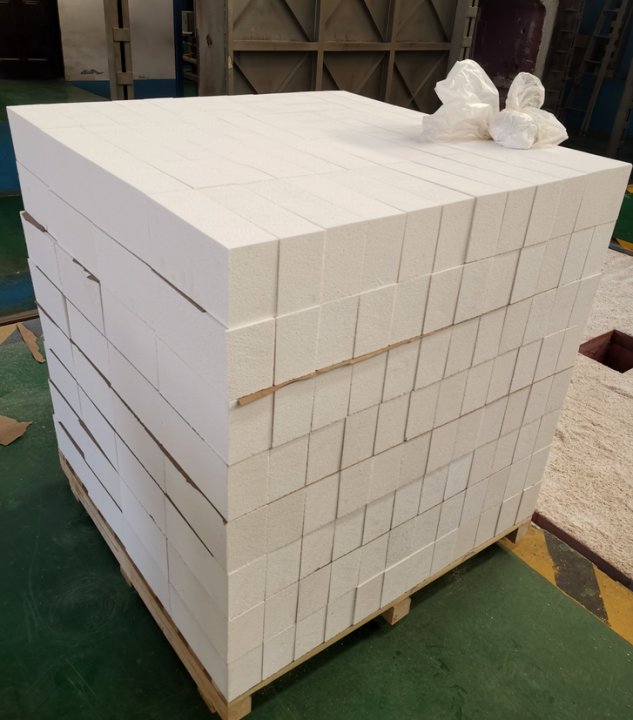56
0
0
What is Bubble Alumina Brick?
4
0
Bubble alumina brick, also known as lightweight alumina brick, is a type of refractory material that is widely used in high-temperature industrial applications. It is composed mainly of alumina (Al2O3) and contains numerous closed-cell voids or bubbles in its structure, giving it a highly porous and lightweight nature.
The production of bubble alumina brick involves a process known as foaming. Foaming agents are added to a mixture of alumina powder, binders, and other additives. These agents generate gas bubbles within the mixture, resulting in a foam-like consistency. The foamed mixture is then shaped into bricks and fired at high temperatures to create the final product.
The unique characteristics of bubble alumina brick make it suitable for various applications where both insulation and resistance to high temperatures are required. Here are some key features and uses of this versatile refractory material:

Lightweight
Bubble alumina brick has a low bulk density due to its porous structure, making it significantly lighter than traditional dense bricks. This lightweight property ensures easier installation and reduces the overall weight of refractory linings.
Excellent Insulation
The presence of closed-cell voids within the soft bubble alumina refractory enhances its thermal insulation properties. These voids act as barriers to heat transfer, reducing energy loss and maintaining stable temperatures in high-temperature environments.
High Refractoriness
Bubble alumina brick exhibits exceptional resistance to heat. It can withstand temperatures up to 1800°C (3272°F) without significant deformation or degradation, making it ideal for applications in furnaces, kilns, and other thermal processes.
Low Thermal Conductivity
The porous structure of bubble alumina brick also contributes to its low thermal conductivity. This property minimizes heat transfer through the material, allowing for better temperature control and energy efficiency in industrial settings.
Corrosion and Erosion Resistance
Alumina, the primary component of bubble alumina brick, is highly resistant to chemical corrosion and erosion. This makes the high temp refractory suitable for use in acidic or alkaline environments, such as petrochemical plants and metal smelting facilities.
Versatile Applications
Bubble alumina brick finds widespread use in various industries. It is commonly employed as insulating linings in furnaces, kilns, and boilers. It is also used for backup insulation in combination with dense bricks or castables. Additionally, bubble alumina brick is utilized in the production of non-ferrous metals, ceramics, and glass.
Conclusion
In conclusion, bubble alumina brick is a lightweight and highly insulating refractory material with excellent resistance to high temperatures, corrosion, and erosion. Its unique properties make it an indispensable component in many industrial processes, providing efficient thermal insulation and contributing to improved energy savings. Whether it's in steel production, petrochemical refining, or ceramic manufacturing, bubble alumina brick plays a crucial role in maintaining optimal operating conditions and prolonging the lifespan of equipment.
The production of bubble alumina brick involves a process known as foaming. Foaming agents are added to a mixture of alumina powder, binders, and other additives. These agents generate gas bubbles within the mixture, resulting in a foam-like consistency. The foamed mixture is then shaped into bricks and fired at high temperatures to create the final product.
The unique characteristics of bubble alumina brick make it suitable for various applications where both insulation and resistance to high temperatures are required. Here are some key features and uses of this versatile refractory material:

Lightweight
Bubble alumina brick has a low bulk density due to its porous structure, making it significantly lighter than traditional dense bricks. This lightweight property ensures easier installation and reduces the overall weight of refractory linings.
Excellent Insulation
The presence of closed-cell voids within the soft bubble alumina refractory enhances its thermal insulation properties. These voids act as barriers to heat transfer, reducing energy loss and maintaining stable temperatures in high-temperature environments.
High Refractoriness
Bubble alumina brick exhibits exceptional resistance to heat. It can withstand temperatures up to 1800°C (3272°F) without significant deformation or degradation, making it ideal for applications in furnaces, kilns, and other thermal processes.
Low Thermal Conductivity
The porous structure of bubble alumina brick also contributes to its low thermal conductivity. This property minimizes heat transfer through the material, allowing for better temperature control and energy efficiency in industrial settings.
Corrosion and Erosion Resistance
Alumina, the primary component of bubble alumina brick, is highly resistant to chemical corrosion and erosion. This makes the high temp refractory suitable for use in acidic or alkaline environments, such as petrochemical plants and metal smelting facilities.
Versatile Applications
Bubble alumina brick finds widespread use in various industries. It is commonly employed as insulating linings in furnaces, kilns, and boilers. It is also used for backup insulation in combination with dense bricks or castables. Additionally, bubble alumina brick is utilized in the production of non-ferrous metals, ceramics, and glass.
Conclusion
In conclusion, bubble alumina brick is a lightweight and highly insulating refractory material with excellent resistance to high temperatures, corrosion, and erosion. Its unique properties make it an indispensable component in many industrial processes, providing efficient thermal insulation and contributing to improved energy savings. Whether it's in steel production, petrochemical refining, or ceramic manufacturing, bubble alumina brick plays a crucial role in maintaining optimal operating conditions and prolonging the lifespan of equipment.